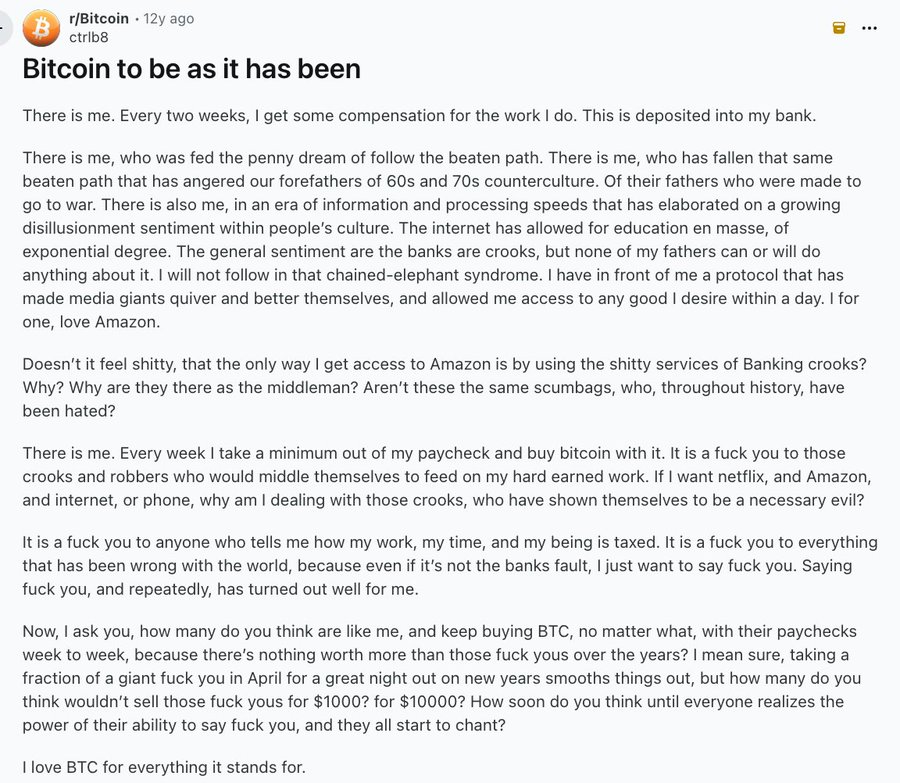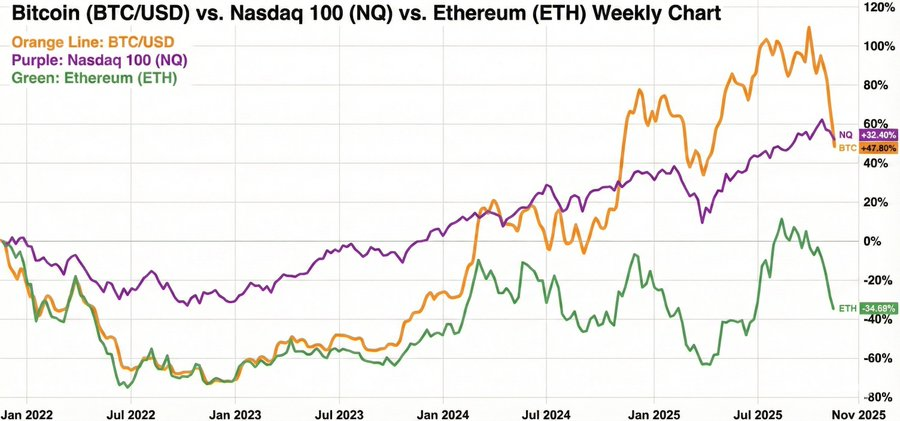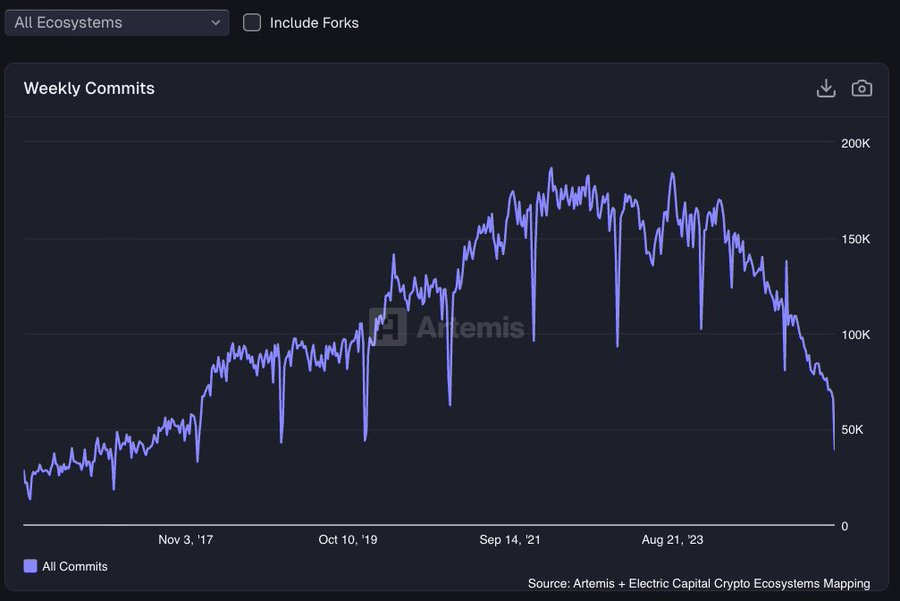Bitcoin Loses Favor? Five Reasons for the Quiet Withdrawal of Capital
Author | @PillageCapital
Compiled by Odaily Planet Daily ( @OdailyChina )
Translator | Dingdang ( @XiaMiPP )

Bitcoin was never the currency of the future; it was merely a battering ram in the regulatory war. And now, this war is nearing its end, with the capital that once supported it quietly withdrawing.
For the past 17 years, we've been convincing ourselves that "magical internet money" is the ultimate form of finance. But that's not the case. Bitcoin is a battering ram in a regulatory war—a siege weapon designed to breach a specific wall, namely, the zero-tolerance stance of governments towards "digital bearer assets."
This task is essentially complete. Tokenized US stocks have begun to be issued, tokenized gold is legally compliant and its scale is constantly growing, and the market capitalization of tokenized US dollars has reached hundreds of billions of dollars.
As the financial system upgrades and becomes more legitimate, the narrative of "digital gold 2.0" is collapsing, returning to what we really wanted in the 1990s: tokenized certificates based on real assets.
I. Background: E-gold
To understand why Bitcoin is becoming obsolete, you must first understand why it was created. It did not miraculously grow spontaneously, but was born in the shadow of numerous failed digital currency experiments.
In 1996, E-gold (the world’s first truly digital gold currency system) was launched. By the mid-2000s, it had about 5 million accounts, processed billions of dollars, and proved something extremely important: the world really needed digital bearer assets backed by hard value.
Then, it was crushed by the state.
In December 2005, the FBI raided E-gold; in July 2008, the founder pleaded guilty. The message was clear: centralized digital gold currencies are too easily destroyed; all it takes is knocking on a door, seizing a server, and prosecuting one person, and the entire system is over.
Three months later, in October 2008, Satoshi Nakamoto published the Bitcoin white paper. He emphasized that the fundamental flaw of traditional currencies and early digital currencies lay in their high dependence on trust in central banks and commercial banks, and that experiments like E-gold further proved that as long as a "point of trust" exists, attacks are easy.
Satoshi Nakamoto witnessed the stifling of a truly groundbreaking digital currency innovation. If you want digital bearer assets to survive, you cannot allow them to be so easily killed again.
Bitcoin was created for this purpose. It wasn't created to pursue efficiency, but to enhance survivability.
II. Rebellious Narrative: The Necessary Illusion
In the early days, bringing new users to Bitcoin was almost like magic. You'd get them to download a wallet on their phone, and when their first coins arrived, the shock was palpable. They'd just opened a financial account and immediately received value—no permission, no documentation, no regulation required.
It was like a slap in the face, and the traditional banking system suddenly seemed old-fashioned and closed off—you didn't even know you were so repressed before.
At Money 20/20 in Las Vegas, a speaker displayed a QR code on a giant screen and conducted a live Bitcoin raffle. Audience members sent Bitcoins, accumulating a prize pool in real time. The traditional finance people around me whispered that the speaker had probably just broken a dozen laws. He might be right, but nobody cared. That's the point.
This is not just finance; it's a rebellion. An early top post on Reddit perfectly captured this sentiment: buy Bitcoin because "it's a powerful blow to the scammers and robbers who try to steal my hard-earned money." 
The growth-driving mechanism is almost perfect. You strive for the "cause"—posting, promoting, debating, recruiting—while simultaneously increasing the value of the coins in your own wallet and your friends' wallets. Rebellion will bring you economic benefits.
And because the network cannot be shut down, it continues to grow after each regulatory crackdown and negative press. Eventually, everyone begins to believe that the "magical internet currency" is the end in itself, not just a stopgap measure.
This illusion was so powerful that even the traditional system eventually began to cooperate : BlackRock began applying for a Bitcoin ETF, the US president discussed making Bitcoin a reserve asset, pension funds and universities began buying exposure, Michael Saylor persuaded convertible bond buyers and shareholders to pay for hundreds of billions of dollars worth of corporate Bitcoin purchases, and the mining industry expanded to the point where its electricity consumption was comparable to that of a medium-sized country.
Ultimately, with over half of the campaign funds coming from the crypto industry, calls for the legalization of cryptocurrencies were finally heard. Ironically, it was precisely the government's early crackdown on banks and payment channels that fueled a $3 trillion "battering ram," forcing regulators to compromise.
III. Rout: When Victory Kills the Trade
The track has been upgraded, the monopoly has been broken. Bitcoin's advantage has never been just its resistance to censorship, but also its monopoly. For a long time, if you wanted tokenized, anonymous value, Bitcoin was the only option. Bank accounts were closed, and fintech companies were too intimidated by regulators to make any moves. If you want instant, programmable money, you have to accept all of Bitcoin's characteristics—including all its roughness and shortcomings.
So we accepted it and embraced it, because we had no other choice.
But that era has ended.
Just look at Tether to see what happens when there's more than one available track. USDT was initially issued on top of Bitcoin, but most of its circulation subsequently migrated to the cheaper and more convenient Ethereum. When Ethereum gas fees skyrocketed, retail investors and emerging markets pushed issuance to Tron. Same dollars, same issuer, just a different channel.
Stablecoins have no loyalty to any chain. They treat the blockchain as a one-time conduit. Assets and issuers are the core; the track is merely a combination of fee structures, availability, and system connectivity. In this sense, the "blockchain over Bitcoin" camp has actually won.
Once you understand this, Bitcoin's position changes completely. When there's only one usable track, everything is forced to sit on it, making it easy to confuse asset value with the value of the underlying pipeline. But as there are more tracks and more substitutes, value naturally slides towards cheaper, more connected pipelines.
This is our current predicament. Most people outside the US can hold tokenized US stocks; perpetual contracts, once considered a "killer app" in crypto, are being replicated by compliant institutions like CME; banks are beginning to support USDT custody and withdrawals; Coinbase is evolving into a hybrid of banking and brokerage, where users can send money, write checks, buy stocks, and buy crypto assets. The network effects that once underpinned Bitcoin's monopoly are gradually crumbling, replaced by general-purpose network infrastructure.
Once the monopoly disappears, Bitcoin will no longer be the only way to access these benefits. It will become a product, competing with compliant, high-quality products that are closer to users' real needs.
During the competition, we overlooked a simple fact: Bitcoin is a terrible payment system. We still need to scan QR codes and copy long strings of meaningless characters to transfer funds. Without a unified username, cross-chain and cross-layer transfers are a hurdle, and a wrong address can mean the permanent loss of assets.

In 2017, Bitcoin transaction fees surged to nearly $100. A Bitcoin café in Prague had to accept Litecoin to stay afloat. I once had dinner in Las Vegas and spent half an hour trying to pay with Bitcoin because people were frantically fiddling with their mobile wallets, causing transactions to fail.
Even today, wallets frequently experience basic glitches. Balance not displaying, transaction delays, and lost funds due to incorrect address input are commonplace in the crypto world.
People click "sign" in their browsers, but have no idea what they're signing. Even established institutions like Bybit can lose billions of dollars due to hacking, with virtually no recourse.
We kept telling ourselves that these user experience issues were just growing pains. But ten years later, what truly improved the user experience wasn't some sophisticated protocol, but centralized hosting services. These services provided users with password management, account recovery, and fiat currency deposit channels.
From a technical standpoint, this is the crux of the problem. Bitcoin has never learned how to truly function without rebuilding the intermediary system it seeks to replace.
This deal is no longer worth the risk. Once other underlying technologies are upgraded, Bitcoin will be nothing but speculation.
Look at the returns over the past four years (a complete cryptocurrency cycle). The Nasdaq outperformed Bitcoin, yet you took on regulatory survival risks, endured dramatic price pullbacks, faced hacks and exchange crashes, and ultimately received a return lower than a typical tech stock index—the risk premium vanished .

Ethereum's situation is even worse. The token that was supposed to provide the highest returns for risk-taking investors has instead been eroding its performance.
Part of the reason is structural. A large number of early holders, whose entire net worth was almost entirely concentrated in crypto assets, are now gradually taking profits and leaving, which is creating billions of dollars of continuous selling pressure.
New inflows are entirely different. ETF buyers and wealth management institutions mostly allocate only 1% or 2% of their funds routinely. While these funds are sticky, they are not aggressive. These modest allocations must contend with continuous OG sell-offs, exchange fees, mining issuances, fraudulent tokens, and hacking attacks to barely keep the price from falling.
The era when "bearing heavy regulatory blows could be exchanged for huge excess returns" is over.
Developers aren't stupid; they can sense when technology loses its edge. Developer activity has fallen back to 2017 levels.

Meanwhile, the core codebase has become stagnant. Changing a decentralized system is inherently difficult by design. Ambitious engineers who once saw encryption as cutting-edge are now moving to new fields like robotics, space, and AI, where they can do things far more exciting than simply "moving numbers."
When speculative returns decline, product experiences worsen, and talent leaves, the future is not hard to imagine.
Fourth, error correction is more important than "pure decentralization".
Decentralization believers tell a simple story: code is law; money is censorship-free; no one can stop or reverse a transaction.
But most people don't actually want that kind of system. What they want is a "financial system that works properly" and "someone to help fix things" when problems arise.
This is most evident in users' attitudes towards Tether. When funds are stolen by North Korean hackers, Tether freezes those balances. For example, if someone accidentally transfers a large amount of USDT to a contract address or a "black hole address," but can still sign from the original wallet, complete KYC verification, and pay the relevant fees, Tether will blacklist the frozen tokens and mint replacement tokens to the correct address. Although this involves some paperwork and time delays, at least there is an executable process. Tether's process includes a manual step to correct errors and rectify deviations.
This is certainly a counterparty risk, but it's the kind of risk people truly value. If you lose money due to technical issues or a hacker attack, at least there's a "slight chance of recovery." But in the on-chain world of Bitcoin, that possibility is zero. If you post the wrong address or sign the wrong transaction, the loss is permanent—no appeals, no customer service, no second chance.
Our trust in issuers is also much stronger than it was in the early days. Back then, "regulation" meant early cryptocurrency businesses losing their bank accounts because banks feared regulators would revoke their licenses. More recently, we've watched some crypto-friendly banks collapse in a single weekend. Regulators seemed more like "executioners" than "referees." But today, the same regulatory framework acts as a safety net: it requires disclosure, mandates issuers' access to auditable structures, and empowers the political and judicial systems to punish blatant theft. Cryptocurrency is now intertwined with political power so deeply that regulators can no longer arbitrarily destroy the entire sector; they must instead tame it. In this environment, "bearing the risks of issuers and regulators" seems far more rational than "losing a private key means losing everything forever."
No one truly needs a completely unregulated financial system. A decade ago, the failure of the regulatory system made the "chaos of no regulation" seem more appealing. But as regulated financial channels continue to upgrade and improve their functions, this trade-off is reversing. People's true preferences have become clear: they want "powerful financial channels," but they also want "referees on the field."
V. From "Magic Network Currency" to "Real-World Asset Tokenization"
Bitcoin has accomplished its mission. It was the battering ram that smashed through the wall blocking E-gold and all similar attempts. It made a political and social impossibility of "forever banning tokenized assets." But this victory also brought a paradox: when the system finally agreed to upgrade, the value of the battering ram itself rapidly diminished.
Crypto assets will still play a role, but we no longer need a $3 trillion "rebel." Hyperliquid developed prototype features with just 11 employees and forced regulators to respond. Once a feature works well in a test environment, traditional finance replicates it and applies regulatory frameworks.
The mainstream strategy today is no longer to bet the majority of your net worth on "magical cryptocurrencies" and hold them for ten years, then pray for good luck. That was a bet only reasonable in an era when old financial channels collapsed and the upward logic was extremely clear. Funds are already shifting direction. Even the "unofficial central bank of the crypto world" is turning: Tether has more gold on its balance sheet than Bitcoin. Tokenized gold and other real-world assets (RWAs) are growing rapidly.
The era of "magical digital currencies" is ending. The era of "tokenization of real-world assets" is beginning. Now that the door has been opened, we can stop worshipping battering rams and focus on the assets and transactions that truly matter in this new world.
- 核心观点:比特币已完成其历史使命。
- 关键要素:
- 代币化美股、黄金、美元已合规化。
- 比特币垄断地位被多轨道替代。
- 用户体验差,回报率低于传统资产。
- 市场影响:资金转向现实资产代币化。
- 时效性标注:长期影响



